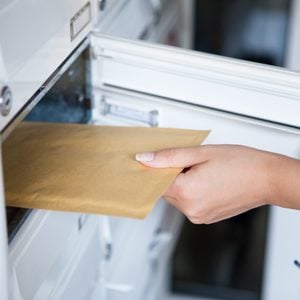We asked a veteran mail carrier to explain what those paw-print stickers mean—and how pet owners can help protect postal workers from dog bites

If You See a Paw-Print Sticker on a Mailbox, Here’s What It Means

If there’s one thing that Tara Snyder, a veteran mail carrier for the U.S. Postal Service, teaches every new mail carrier she trains, it’s this: “Even if a dog is friendly to you 364 days a year, they can have a bad day too—and bite you,” she says. “If they have teeth, they can bite.”
She knows of what she speaks. In April 2024, Snyder was doing her usual route in Pennsylvania when she approached a resident’s door to get a signature for a piece of mail. Before she realized what was happening, a 70-pound dog launched out the door and went right for her hand. She tried to block it with her mailbag, but it was too late. “It ripped my hand open pretty bad,” she says, noting that she ended up needing 17 stitches, a tetanus shot, a round of antibiotics and three weeks off work to recover. “The worst part was that it bit my right hand, and I’m right-handed.”
It wasn’t the first or last confrontation between a mail carrier and a vicious dog at that address. In fact, a different dog cornered Snyder on the porch during a separate visit. (Thankfully, she wasn’t bitten that time.) Animal Control is looking into the owners, and the Postal Service is doing everything it can to stop its mail carriers from getting bitten. Because the fact is, Snyder is not alone: There were 5,800 incidents involving dogs and postal workers in 2023, according to Postal Service data.
That brings us to the colored paw-print stickers you may have spotted on mailboxes. Ahead, we’ll explain their meaning, the replacement system that’s keeping mail carriers safe and what you can do if you’re a dog owner.
Get Reader’s Digest’s Read Up newsletter for more news, interesting facts, travel, tech and humor all week long.
The Paws mailbox sticker program
In 2020, the Postal Service rolled out the Paws Program in select cities around the country. Workers placed paw-print stickers on the mailboxes of homes known to have dogs: an orange sticker to indicate that a dog lives at that address and a yellow sticker to signal that a dog lives next door. The goal was to let Postal Service workers and other delivery people know they should be on the lookout for dogs or other animals at that address—especially dogs who don’t react well to mail carriers.
The program is no longer active, though you may still spy the stickers on some mailboxes. If you see one on someone else’s mailbox, leave it where it is and take it as a sign that a dog may live there. If you see a sticker on your own mailbox, you can either leave it or remove it.
The new Postal Service dog-alert system
“The Postal Service has pivoted away from the sticker-based Paw Program and implemented a digital and more effective, sustainable method for alerting letter carriers of potential dangers,” says Amy Gibbs, a spokesperson for the service.
That’s right: Your mail carriers have gone high-tech. The same scanner they use on packages now customizes warnings to the exact location, time and situation of individual postal workers.
“To help protect our employees, the hand-held scanners used by our carriers to confirm customer delivery include a feature to indicate the presence of a dog at an address,” Gibbs explains. “And the USPS Informed Delivery service alerts customers to mail and packages coming to their homes, allowing them to plan for the carrier’s arrival and secure their dogs safely.”
Snyder loves the new program—it’s part of the National Dog Bite Awareness Campaign—as it can alert mail carriers about all kinds of dangers and provide updates on the go. The only downside of the digital system for her: “It doesn’t help other delivery people, like DoorDash drivers or FedEx, and I don’t know if they have a similar warning system,” she says.
What you can do to help protect your mail carrier

“I am such an animal lover, and I never want to have anything bad happen to a dog,” Snyder says. “Preventing animal attacks is the best way to protect us and your dog. And don’t say, ‘My dog would never.’ Because any dog can bite under the wrong circumstances.”
The No. 1 tip for preventing your dog from biting a mail carrier? “Secure your dog,” both Snyder and Gibbs say. This starts with putting your dog inside when you know the mail carrier is coming, but it doesn’t stop there.
“Be aware of what your dog can do,” Snyder says. “Many dogs can open latch doors by jumping on the handle, leap over fences or gates, or barrel through screen doors if they feel threatened. You may need to add extra locks.”
Other tips for dog owners:
- Tell your mail carrier ahead of time about your dog.
- Don’t allow your dog to roam freely.
- Fence in your yard, and put your mailbox outside the fence.
- Use Informed Delivery (it’s a free service!) for packages that need to be brought to your door.
- Don’t allow children to accept mail directly from the carrier, as the dog may become protective of the child.
- Keep your dog current on its vaccines, including rabies.
- Ensure your dog is covered under your homeowners or renters insurance policy.
That last one is important. Many people don’t realize that they will be held personally responsible for the medical bills, lost wages and uniform-replacement costs associated with their dog biting a mail carrier, Gibbs says.
The Postal Service takes steps to educate and equip their workers to prevent animal bites, but at the end of the day, the responsibility is on the pet owner, Gibbs says. One of the things your mail carrier may not tell you? If you don’t or can’t secure your dog, you may not be able to have your mail delivered anymore. “If a carrier feels threatened by a vicious dog, or if a dog is running loose, we may ask the owner to pick up their mail at the post office,” she says.
About the experts
|
Why trust us
At Reader’s Digest, we’re committed to producing high-quality content by writers with expertise and experience in their field in consultation with relevant, qualified experts. We rely on reputable primary sources, including government and professional organizations and academic institutions as well as our writers’ personal experiences where appropriate. We verify all facts and data, back them with credible sourcing and revisit them over time to ensure they remain accurate and up to date. Read more about our team, our contributors and our editorial policies.
Sources:
- Tara Snyder, U.S. Postal Service mail carrier in Pennsylvania; phone interview, Sept. 10, 2024
- Amy Gibbs, spokesperson for the U.S. Postal Service; email interview, Sept. 4, 2024
- U.S. Postal Service: “U.S. Postal Service Releases Dog Bite National Rankings”
- U.S. Postal Service: “National Dog Bite Awareness Campaign”



